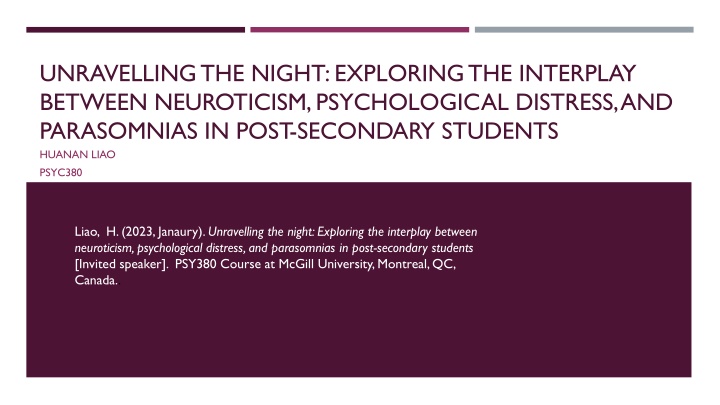
Interplay between Neuroticism, Psychological Distress, and Parasomnias in Post-Secondary Students
Explore the complex relationship between neuroticism, psychological distress, and parasomnias in post-secondary students through a cross-sectional study. Discover how factors like ego strength, trait neuroticism, and state distress impact nightmares frequency. Utilizing various questionnaires and screening tools, this research sheds light on the prevalence and effects of parasomnias in young adults.
Download Presentation

Please find below an Image/Link to download the presentation.
The content on the website is provided AS IS for your information and personal use only. It may not be sold, licensed, or shared on other websites without obtaining consent from the author. If you encounter any issues during the download, it is possible that the publisher has removed the file from their server.
You are allowed to download the files provided on this website for personal or commercial use, subject to the condition that they are used lawfully. All files are the property of their respective owners.
The content on the website is provided AS IS for your information and personal use only. It may not be sold, licensed, or shared on other websites without obtaining consent from the author.
E N D
Presentation Transcript
UNRAVELLING THE NIGHT: EXPLORING THE INTERPLAY BETWEEN NEUROTICISM, PSYCHOLOGICAL DISTRESS, AND PARASOMNIAS IN POST-SECONDARY STUDENTS HUANAN LIAO PSYC380 Liao, H. (2023, Janaury). Unravelling the night: Exploring the interplay between neuroticism, psychological distress, and parasomnias in post-secondary students [Invited speaker]. PSY380 Course at McGill University, Montreal, QC, Canada..
BACKGROUND(1/3) Kirwan & Fortune, 2021 N = 135; university students Hypnic jerks (79.3%), nightmares (74.1%), sleep-talking (57.8%) 97.8% experienced at least one parasomnia symptom
BACKGROUND(2/3) Wang et al., 2023 N = 408; adolescent psychiatric patients 49.3% reported frequent nightmares Distress Frequency --------------------- Depression Girls > boys
BACKGROUND(3/3) Kelly, 2020 N = 416; undergrads Ego strength predicted nightmares frequency above trait neuroticism and state distress. W/o ES, Only distress predicted nightmares.
METHODS(1/2) Cross-sectional N = 85; post-secondary students Bilingual Procedure
METHODS(2/2) Munich Parasomnia Screening Questionnaire (MUPS) (Fulda et al., 2008) Eysenck Personality Questionnaire-Revised (EPQR) (Francis et al., 1992) Sleep Symptom Checklist (SSC) (Bailes et al., 2007)
MUPS Likert scale (0-6) Frightening dreams and nightmares Talking during sleep Leg or body twitches that occur suddenly and unintentionally when falling asleep, often with the sensation of falling
EPQR Yes or no Often feel fed up? Would you call yourself a nervous person? Are you a worrier? Do you feel lonely? Do you suffer from nerves? Does your mood go up and down?
SSC Assess sleep quality, insomnia, sleep disorder, and psychological maladjustments (0-3). Anxiety , Depression , Poor emotional wellbeing
ANALYSES SPSS Independent sample t-tests Bivariate correlational analyses
DISCUSSION & IMPLICATIONS Psychological maladjustments & Neuroticism frequency of parasomnias Comorbidities
LIMITATIONS Snowball Sampling Small sample size Correlations =/= causation
FUTURE DIRECTIONS Longitudinal studies Clinical intervention studies (e.g., addressing underlying factors in therapy)
CITATIONS Bailes, S., Baltzan, M., Rizzo, D., Fichten, C. S., Amsel, R., & Libman, E. (2008). A diagnostic symptom profile for sleep disorder in primary care patients. Journal of Psychosomatic Research, 64(4), 427-433. Fulda, S., Hornyak, M., M ller, K., Cerny, L., Beitinger, P. A., & Wetter, T. C. (2008). Entwicklung und Validierung des M nchner Parasomnie-Screening (MUPS): Ein Fragebogen zur Erfassung von Parasomnien und n chtlichen Verhaltensweisen: A questionnaire for parasomnias and nocturnal behaviors. Somnologie-Schlafforschung und Schlafmedizin, 12, 56-65. Francis, L. J., Brown, L. B., & Philipchalk, R. (1992). The development of an abbreviated form of the Revised Eysenck Personality Questionnaire (EPQR-A): Its use among students in England, Canada, the USA and Australia. Personality and individual differences, 13(4), 443-449. Kirwan, E., & Fortune, D. G. (2021). Exploding head syndrome, chronotype, parasomnias and mental health in young adults. Journal of Sleep Research, 30(2), e13044. Kelly, W. E. (2020). Nightmares and ego strength revisited: Ego strength predicts nightmares above neuroticism and general psychological distress. Dreaming, 30(1), 29. Wang, Z., Zhang, K., He, L., Sun, J., Liu, J., & Hu, L. (2023). Associations between frequent nightmares, nightmare distress and depressive symptoms in adolescent psychiatric patients. Sleep Medicine, 106, 17-24.
